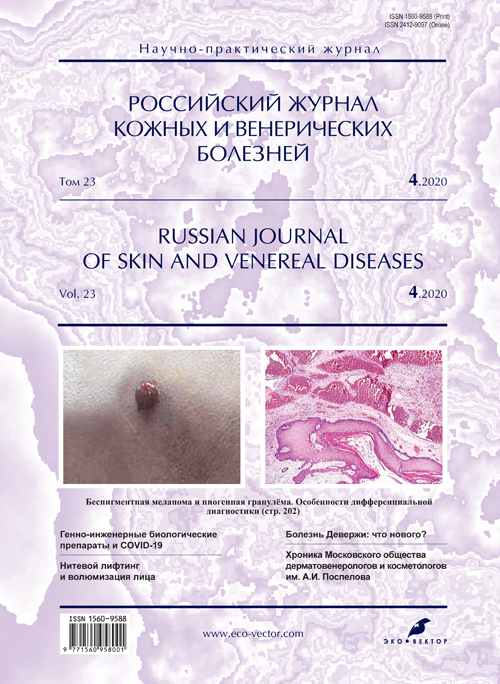Evaluation of the effectiveness of long-term interruption and resumption of therapy with ustekinumab in psoriasis patients with metabolic disorders
- Authors: Rychkova I.V.1, Pritulo O.A.2, Maraqa M.Y.2, Babanin V.A.2
-
Affiliations:
- Clinical Dermatovenerologic Hospital
- Medical Academy n.a. S.I. Georgievsky of Vernadsky Crimean Federal University
- Issue: Vol 23, No 4 (2020)
- Pages: 212-217
- Section: CLINICAL PICTURE, DIAGNOSIS, AND THERAPY OF DERMATOSES
- URL: https://rjsvd.com/1560-9588/article/view/48919
- DOI: https://doi.org/10.17816/dv48919
- ID: 48919
Cite item
Abstract
BACKGROUND: Psoriasis is a chronic immune-mediated inflammatory skin disease. The goal of psoriasis therapy is to achieve long-term stable remission and improve the patients quality of life. Continuity of therapy is the basis for successful disease control. To achieve this goal, the most effective genetic engineered biological drugs are currently used. However, in some patients the biologicals demonstrated insufficient effectiveness. The presence of comorbidities, in particular metabolic syndrome in such cases, is one of the reasons for low therapeutic response.
AIM: This study aimed to evaluate the therapeutic effectiveness of ustekinumab in psoriasis patients with metabolic syndrome after a long interruption and resumption of therapy.
MATERIALS AND METODS: We observed 68 patients diagnosed with advanced plaque psoriasis. They were divided into two groups according to their body mass index and metabolic disorders.
RESULTS: By week 24, 96.8% of the patients in group 1 and 91.6% in group 2 reached PASI 75. By week 48, 100% of the patients in group 1 and 86.1% in group 2 reached PASI 75. By week 76, PASI 75 was observed in 96.8% of patients receiving 45 mg of ustekinumab and in 83.3% of patients receiving 90 mg of ustekinumab. Treatment with ustekinumab was discontinued at week 76 due to economic factors. The therapy was discontinued for 36 weeks. By week 112, 86.7% of the patients in both groups had a relapse of psoriasis, which was assessed by the loss of therapeutic response. By week 124 (12 weeks after the resumption of therapy), PASI 75 was reached in 93.7% of the patients in group 1 and 77.7% in group 2. By week 136, all patients in group 1 had achieved PASI 75, and by week 128, 83.3% of patients in group 2 had PASI 75.
CONCLUSIONS: In patients with psoriasis on ustekinumab therapy, a long-term (36 weeks) interruption and resumption of therapy is possible. However, in patients with comorbid pathology, effectiveness is dimi-nished; thus, new methods of pathogenetic therapy to correct metabolic disorders are needed.
Keywords
Full Text
About the authors
Irina V. Rychkova
Clinical Dermatovenerologic Hospital
Author for correspondence.
Email: zkissskaz@mail.ru
ORCID iD: 0000-0002-8690-8727
MD, dermatologist
Russian Federation, SimferopolO. A. Pritulo
Medical Academy n.a. S.I. Georgievsky of Vernadsky Crimean Federal University
Email: zkissskaz@mail.ru
ORCID iD: 0000-0001-6515-1924
Russian Federation, Simferopol
Marwan Yakin Naje Maraqa
Medical Academy n.a. S.I. Georgievsky of Vernadsky Crimean Federal University
Email: zkissskaz@mail.ru
ORCID iD: 0000-0002-5579-4413
Russian Federation, Simferopol
V. A. Babanin
Medical Academy n.a. S.I. Georgievsky of Vernadsky Crimean Federal University
Email: zkissskaz@mail.ru
ORCID iD: 0000-0003-4248-187X
Russian Federation, Simferopol
References
- Kubanov AA, Ziryanov SK, Belousov DYu. Clinical and economic analysis of biologic drugs in treatment of psoriasis. Good Clinical Practice. Russian Journal. 2015;(3):34-42. (in Russian)
- Kungurov NV, Kokhan MM, Keniksfest YuV. Biological therapy of patients with severe psoriasis. Herald of Venerology and Dermatology. Russian Journal. 2012;88(4):91-5. (in Russian)
- Suskova VS, Pinson IYa, Olisova OYu. Immunopathological mechanisms of psoriasis. Russian Journal of Clinical Dermato- logy and Venerology. 2006;4(1):68-70. (in Russian)
- Olisova OYu, Teplyuk NP, Pinegin VB. Modern methods of psoriasis treatment. Russian Medical Journal. Dermatology. 2015;23(9):483-4. (in Russian)
- Olisova OYu, Garanyan LG. Epidemiology, etiopathogenesis, comorbidity in psoriasis – new facts. Russian Journal of Skin and Venereal Diseases. 2017;20(4):214-9. (in Russian)
- Khairutdinov VR, Belousova IE, Samtsov AV. Immune pathogenesis of psoriasis. Herald of Venerology and Dermatology. Russian Journal. 2016;92(4):20-6. (in Russian)
- Dovzhansky SI, Pinson IYa. Genetic and immune factors in the pathogenesis of psoriasis. Russian Journal of Skin and Venereal Diseases. 2006;9(1):14-9. (in Russian)
- Ryan C, Menter A. Psoriasis and cardiovascular disorders. G Ital Dermatol Venereol. 2012;147(2):179-87.
- Takeshita J, Grewal S, Langan SM, Mehta NN, Ogdie A, Van Voorhees A, Gelfand JM. Psoriasis and comorbid diseases: Epidemiology. J Am Acad Dermatol. 2017;76(3):377-90. doi: 10.1016/j.jaad.2016.07.064.
- Paschoal RS, Silva DA, Cardili RN, Souza CS. Metabolic syndrome, C-reactive protein and cardiovascular risk in psoriasis patients: a cross-sectional study. An Bras Dermatol. 2018;93(2):222-8. doi: 10.1590/abd1806-4841.20186397.
- Rosete-Pidal EA, Kruglova LS, Ponich ES, Chorbinskaya SA, Filatova EV. Preparations in theatment of psoriasis patients with concurrent metabolic syndrome: efficiency predictors and potential risks. Russian Journal of Occupational Health and Industrial Ecology. 2017;(8):33-8. Available at: https://www.journal-irioh.ru/jour/article/view/661/651. (in Russian)
- Mantovani A, Gisondi P, Lonardo A, Targher G. Relationship between non-alcoholic fatty liver disease and psoriasis: a novel hepato-dermal axis? Int J Mol Sci. 2016;17(2):217. doi: 10.3390/ijms17020217.
- Wolk K, Sabat R. Adipokines in psoriasis: an important link between skin inflammation and metabolic alterations. Rev Endocr Metab Disord. 2016;17(3):305-17. doi: 10.1007/s11154-016-9381-0.
- Ng Chau Yee, Tzeng I-Shiang, Liu Su-Hsun, Chang Ya-Ching, Huang Yu-Huei. Metabolic parameters in psoriatic patients treated with interleukin-12/23 blockade (ustekinumab). J Dermatol. 2018;45(3):309-13.
- Stefanadi E, Dimitrakakis G, Antoniou C, Challoumas D, Punjabi N, Dimitrakaki I, et al. Metabolic syndrome and the skin: a more than superficial association. Reviewing the association between skin diseases and metabolic syndrome and a clinical decision algorithm for high risk patients. Diabetol Metab Syndr. 2018;10:9. doi: 10.1186/s13098-018-0311-z.
- Abdellatif AM, Shishova TA. Metabolic syndrome and its impact on the major cardiovascular events in patients with acute coronary syndrome. Modern Problems of Science and Education. Russian Journal. 2015;(1-1):1346. (in Russian)
- Machado-Pinto J, dos Santos Diniz M, Couto Bavoso N. Psoriasis: new comorbidities An Bras Dermatol. 2016;91(1):8-14. doi: 10.1590/abd1806-4841.20164169.
- Sokolovsky EV, Kruglova LS, Ponich ES. The flaws of total systems therapy with biological preparation for psoriasis. Russian Journal of Skin and Venereal Diseases. 2015;18(6):32-8. (in Russian)
- Gisondi P, Fostini A, Fossa I, Girolomoni G, Targher G. Psoriasis and the metabolic syndrome. Clin Dermatol. 2018;36(1):21-8. doi: 10.1016/j.clindermatol.2017.09.005.
Supplementary files











